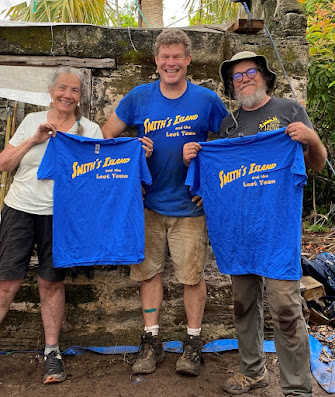Enough with the rain already!
 |
| Morning bailing after a night of rain |
But we are undaunted, crossing the harbour through sheets of rain and huddling under tarps as we dig through the drizzle. Although we've only managed around four days of actual excavation, we've made some great progress and found some strange stuff (which is early, since surprises typically show up at the end of week four).
To break in the new diggers, we opened up the units connecting Locus A and B, which we didn't get to last summer. In part, we were chasing down apparent lines of post holes to follow out the edges of structures (or seeing where they might turn corners) but we also wanted to establish where there were "empty" spaces between buildings and also to add to our assemblage of material related to the military "GR" standing ruin occupation period.
This area is yielding artifacts consistent with past seasons' finds, including items reflecting civilian presence on this ostensibly military site such as children's clay marbles, buttons, sewing needles, and several mother-of-pearl fragments that appear to be parts of fan blades, along with the usual clay pipe stems and bowls, animal bones, Annularware and transfer print plates.
 |
| A clay marble marked with an "X" |
We have also fully uncovered the large deep feature we identified in August 2022 and have begun to excavate within it. The top layer is very artifact-rich, with faunal material, building debris, lots of thin pale green window glass, and ceramics typical of the early-mid-eighteenth century aside from a few Creamware sherds. It appears to be nicely sealed and predates the construction of the ruin next to it. One emerging interpretation is that this may relate to the site's Bermudian civilian Smallpox Quarantine phase (c. 1740-1790), destroyed to make way for the later, surviving Military Yellow Fever structure - which, incidentally, just celebrated its birthday: on the interior western wall, someone carved "26th of May ..." and where the year would appear a later someone cut a window!
We have also put our first visitors and volunteers to work, including Flo, an experienced archaeologist from London, Atlantic World and Caribbean history scholar Carla Pestana and her husband Don, and Bermudians Ari and E. Michael - and hope to see many more over the next month! We also have debuted our new 2023 shirts, made with a nod toward the last Indiana Jones movie coming out this summer.The Globe Archaeology Lab is up and running as well, processing our field finds in real time.Finally, we are trying to fix our severe lack of water transportation by refurbishing an old sailboat that needs a new keel. Our trusty overworked whaler can at best carry six on a calm day and thus has to make many trips across the harbour daily and thus far no one has come forward with offers to lend a boat. Between showers on Friday Kaspar and Josh and Tristan took a crack at prepping an old hull to build up a keel while Flo took me timber-shopping at SAL. It seems a very historical and Bermudian thing to do some shipbuilding and salvage work, especially in Old St. George's at a spot that actually was a shipyard in the 1710s and 1720s. Hopefully we will get her seaworthy in a week or two and then only have to make single crossings daily - and have two boats so the Smith's Island and St. George's Lab teams can each commute to work separately!




















.jpg)
Comments